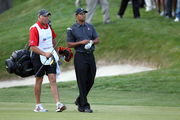

So remember how Matt Fitzpatrick’s Sunday round at the BMW Championship took an unexpected turn? He discovered a crack on the face of his driver, which halted his momentum despite birdieing the first three holes. Fitzpatrick called for a ruling on the eighth hole, but the PGA Tour officials deemed that the crack didn’t meet the standard of being “significantly damaged” under the current rules. Fitzpatrick was visibly frustrated with the decision, calling it “outrageous” and “an absolute joke.” He was forced to switch to his 3-wood for the remainder of the round.
Watch What’s Trending Now!
In the latest update from the PGA Tour Rules Committee, a revised version of Model Local Rule G-9 will come into effect on January 1, 2025. This new rule will allow players to replace damaged clubs, including those with cracks in the club head or clubface, audible rattles, or dents/kinks in the shaft. The replacement club must be similar to the damaged one, filling the gap in the player’s set. For instance, a cracked driver can only be replaced by another driving club. This revision aims to provide clarity and consistency in dealing with damaged equipment during competitions.
The new rule may have changed the outcome for Fitzpatrick if it were in effect during the BMW Championship. Under the revised rule, his cracked driver would have been deemed significantly damaged, allowing him to replace it with a similar club. Instead, Fitzpatrick had to adapt to using his 3-wood, which impacted his performance.
ADVERTISEMENT
Article continues below this ad
New rule. That will always be known as the Matt Fitzpatrick rule pic.twitter.com/KvhCA89NwE
— Monday Q Info (@acaseofthegolf1) December 16, 2024
He eventually finished tied for 28th place and failed to advance to the Tour Championship. The introduction of the revised rule in 2025 may help prevent similar situations in the future, providing players with more flexibility in managing their equipment during competitions.
ADVERTISEMENT
Article continues below this ad
Top Stories
Tiger Woods’ Treatment of Caddies Set Him Apart from PGA Tour Rivals, Confesses Steve Williams

Rickie Fowler Comes Clean on Health Issue Stopping Him from Playing PGA Tour Events

Paige Spiranac Chokes Back Tears as She Opens Up on the Dark Reality of Being an Influencer

Judy Bell, USGA’s Groundbreaking Leader Who Inspired Generations, Dies at 89

Phil Mickelson Is Unimpressed With LIV Golf Revamp as Jon Rahm Gives His Stamp of Approval

This was the ‘real reason’ that Matt Fitzpatrick was not allowed to replace his driver
Just 4 months ago, Bunkered released a report stating the real reason behind the denial of replacing drivers with cracked faces. According to their findings, the rule is actually designed to prevent manufacturers from building drivers with super-thin faces that would produce insane ball speeds. This report shed light on the fact that if pros were allowed to replace drivers with any sort of crack, manufacturers would push the limits of driver design, leading to more cracks and replacements. Fast forward to the BMW Championship, and Matt Fitzpatrick found himself at the center of a controversy that exposed the flaws in this rule. The former US Open champion was left outraged when a rules official refused to let him replace his clubhead after spotting a crack on the face of his driver.
“The rule is written this way to counteract the ‘spring effect’ or ‘characteristic time’ rule measuring ball speed with a driver,” said a tour insider. “A driver must be ‘significantly damaged’ to be replaceable, which basically means cracked all the way through or caved in/collapsed completely.” The insider added, “If pros were allowed to replace a driver with any sort of crack, manufacturers would build the faces as thin as legally possible… It is a roundabout way of controlling distance.” These comments provide a glimpse into the reasoning behind the rule, but for Fitzpatrick, it was little consolation after being denied a replacement driver.
ADVERTISEMENT
Article continues below this ad
ADVERTISEMENT
ADVERTISEMENT
ADVERTISEMENT
ADVERTISEMENT

